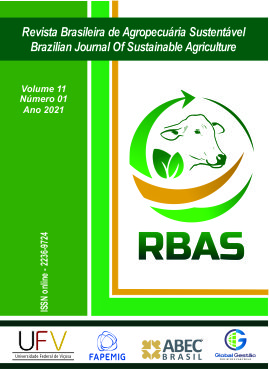Soil physical and chemical quality in reforestation areas, in Amazon, Brazil
Soil physical and chemical quality in reforestation areas, in Amazon, Brazil
DOI:
https://doi.org/10.21206/rbas.v11i1.12776Keywords:
Agriculture, Recovery and Conservation of soil, forest speciesAbstract
The rapid growth of agriculture, promoted by public initiatives, favored uncontrolled deforestation, so that today it is necessary to use sustainable alternatives for soil improvement and conservation. In this context, the present study aimed to comparatively assess soil quality, through the physical and chemical attributes of the soil, in areas with different times of reforestation, in the plateau, Santarém, Pará, Brazil. The research was developed in five areas, namely: reforestation area with eight years (AR8), reforestation area with seven years (AR7), reforestation area with six years (AR6), degraded pasture area (APD) and fragment native forest (FNF). The deformed and undisturbed soil samples were collected at the depths of 0.00 - 0.05 m; 0.05 - 0.10 m and 0.10 - 0.20 m, with eight replicates per area and a total of 120 deformed and 120 undisturbed samples. The chemical attributes (P, K+, Na+, Ca2++Mg2+, H++Al3+, effective CTC, pH, base saturation, saturation by aluminum and organic matter) and physical soil (soil density, particle density) were evaluated and total porosity). The reforestation areas AR8 and AR7 showed results statistically equal to those of FFN for physical attributes. AR6 and APD obtained greater compaction in the 0.0-0.5 m layer. The FFN, in turn, presented low CTC and high acidity index, probably due to the intense deposition and decomposition of litter on its surface. The soil conditions in reforestation at eight and seven, demonstrate that after this period, there was an improvement, mainly in the physical quality of the soil, with values that are equal to under natural conditions. The six-year period was not enough to recover the physical quality of the soil. The temporary presence of animals in the reforestation areas contributed to the increase in soil fertility.Downloads
Downloads
Published
2021-12-31
How to Cite
Amorim Silva do Sacramento, J. A., Rachor Taglieber, A., Moreira Pompeu, J. C. . ., Sousa Filho , M. ., Resende Silva , A. ., & Cristi de Barros, E. . (2021). Soil physical and chemical quality in reforestation areas, in Amazon, Brazil: Soil physical and chemical quality in reforestation areas, in Amazon, Brazil. Brazilian Journal of Sustainable Agriculture, 11(1), 403–412. https://doi.org/10.21206/rbas.v11i1.12776
Issue
Section
Artigos
License
Copyright (c) 2021 Brazilian Journal of Sustainable Agriculture

This work is licensed under a Creative Commons Attribution-NonCommercial-NoDerivatives 4.0 International License.
1. Proposta de Política para Periódicos de Acesso Livre
Autores que publicam nesta revista concordam com os seguintes termos:
Autores mantém os direitos autorais e concedem à revista o direito de primeira publicação, com o trabalho simultaneamente licenciado sob a Licença Creative Commons Attribution que permite o compartilhamento do trabalho com reconhecimento da autoria e publicação inicial nesta revista.











